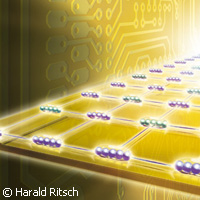New architecture for quantum computers
A new architecture for quantum computation has emerged, according to a study published in Nature. Partial support for this study came from the EU-funded projects MICROTRAP (' Development of a pan-European Microtrap Technology capability for Trapped Ion Quantum Information Science') and SCALA ('Scalable quantum computing with light and atoms'). Both MICROTRAP and SCALA were funded under the 'Information society technologies' (IST) Thematic area of the Sixth Framework Programme (FP6) to the tune of EUR 1.77 million and EUR 9.36 million respectively. Six years ago, scientists at the University of Innsbruck in Austria realised the first quantum byte - a quantum computer with eight entangled quantum particles. This is a record that still stands, but 'nevertheless, to make practical use of a quantum computer that performs calculations, we need a lot more quantum bits,' commented Professor Rainer Blatt from the university's Institute for Experimental Physics. He, along with his research team, created the first quantum byte in an electromagnetic ion trap. But, as he explained 'in these traps we cannot string together large numbers of ions and control them simultaneously'. To solve this problem, the scientists started to design a quantum computer based on a system of many small registers that must be linked; they developed a revolutionary approach based on a concept formulated by theoretical physicists Ignacio Cirac and Peter Zoller. The latter are regarded as leaders in the areas of cold atoms, quantum optics and quantum information with, at the core of their research, the use of the microscopic world to build quantum computers and communication systems. In their experiment, the physicists managed to electromagnetically couple 2 groups of ions over a distance of about 50 micrometres, where the motion of the particles serves as an antenna. 'The particles oscillate like electrons in the poles of a TV antenna and thereby generate an electromagnetic field,' Professor Blatt explained. 'If one antenna is tuned to the other one, the receiving end picks up the signal of the sender, which results in coupling.' The energy exchange that takes place in this process could be the basis for fundamental computing operations of a quantum computer, according to the team. 'We implemented this new concept in a very simple way,' Professor Blatt pointed out. In a miniaturised ion trap a double-well potential was created, trapping the calcium ions. The two wells were separated by 54 micrometres. 'By applying a voltage to the electrodes of the ion trap, we were able to match the oscillation frequencies of the ions,' he added. 'This resulted in a coupling process and an energy exchange, which can be used to transmit quantum information.' A direct coupling of two mechanical oscillations at the quantum level has never been demonstrated before. In addition, the scientists showed that the coupling is amplified by using more ions in each well. 'These additional ions function as antennae and increase the distance and speed of the transmission,' Professor Blatt said. He expressed his excitement about the new concept, which constitutes a promising approach for building a fully functioning quantum computer. 'The new technology offers the possibility to distribute entanglement. At the same time, we are able to target each memory cell individually,' he said. The new quantum computer could be based on a chip with many micro traps, where ions communicate with each other through electromagnetic coupling. This approach represents an important step towards practical quantum technologies for information processing, concluded the team.For more information, please visit: University of Innsbruckhttp://www.uibk.ac.at/Naturehttp://www.nature.com/
Countries
Austria



